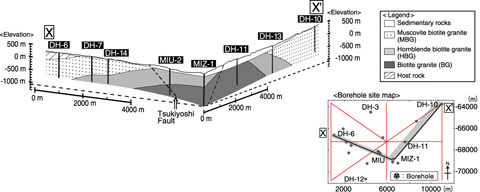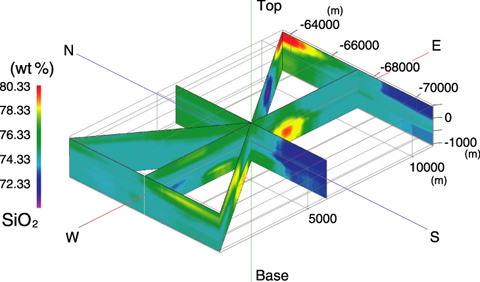
Fig.2-12 Rockfacies columns for the Toki granite

Fig.2-13 Contoured spatial distribution of SiO2 concentration in a fence diagram along the red lines in borehole site map (Fig.2-12)
An important subject in studies of crustal evolution is the development of an understanding of the formation (intrusion and emplacement processes) of granitic plutons. Heat transfer to the surrounding host rock during intrusion of granitic magma plays a vital role in the development of metamorphic rock. Granitic and metamorphic rocks account for a large part of the continental crust. That is, knowing how granitic plutons form is a “keystone” to understanding the evolution of the continental crust. Differences in formation processes are likely reflected in petrophysical properties, which eventually effects fracture formation.
This study presents the results of petrographical studies of spatial variations in rock facies (mineral assemblage and mode) and chemistry recorded in the Toki granite of central Japan, and evidence from the formation of this pluton. Samples collected from 19 boreholes in the Toki granite display spatial variations in both rock facies (Fig.2-12) and chemistry (Fig.2-13). Based on these variations, the Toki granite is divisible into three rock facies ranging from muscovite biotite granite (MBG) at the margin, to hornblende biotite granite (HBG), and to biotite granite (BG) in the interior (Fig.2-12). Spatial SiO2 distribution in the granite shows high concentrations in the upper NE margin, lower concentrations in the central part of the intrusion, and the lowest concentrations in the intervening region (Fig.2-13). The chemistry of the body is related to the change in rock facies from the upper margin, the lower central region, and the intermediate region between them, which respectively correspond to the MBG, BG and HBG.
These petrographical variations could be due to two different formation possibilities: either assimilation of crustal host rocks into the granitic magma during intrusion, or simultaneous intrusion of different magmas. Assimilation would be evident in zonal variations in which rock facies and chemistry are closer to the host rock, towards the margin of the body. Simultaneous intrusion of different magmas can also yield zonal variations, as the three rock facies and the corresponding chemical variation are derived from three different magmas.
The addition of isotope and trace element examination to this study will enable us to further understand the formation process. This study will also contribute to the safety evaluation of a geological disposal system, through understanding the characteristics of fracture formation.